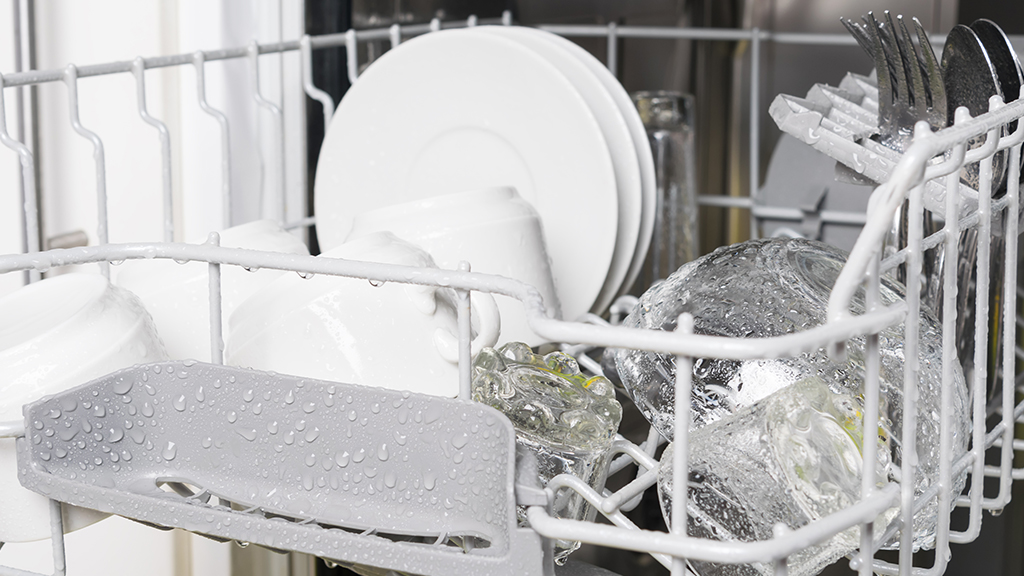Here's a problem you may have experienced: Your dishwasher finishes a cycle, but when you go to unload the dishes, they're still damp or wet. Now what?
Here at Asurion, we don't just fix appliances: We fix the frustration you feel when yours don't work—whether your dishwasher won't start or you need to fix a leaking dishwasher. Here's our guide to why your dishwasher may not be drying dishes and what to do about it.
Why is my dishwasher not drying?
There are several reasons your dishwasher may not be drying your dishes properly:
- You're loading the dishes incorrectly.
- You chose the wrong drying cycle setting.
- You didn't add rinse aid.
- There is a faulty or burned-out heating element.
- There is a closed or broken vent.

Psst... Got 2 minutes?
That’s how long it takes to get a care plan personalized for you:
✓ Coverage for thousands of devices ✓ Fast, quality fixes
✓ Hands-on help when you need it
What to do when your dishwasher is not drying dishes
Now you know some of the potential reasons your dishwasher is leaving your dishes soggy, let's dive into some troubleshooting steps.
Make sure you're loading your dishwasher properly
Sometimes your dishes won't dry because your machine isn't loaded correctly. Here are some tips to make sure your dishes dry better:
- When loading the dishwasher, don't overfill it.
- Place cups, glasses, small bowls, and dishwasher-safe plastics in the top rack.
- Load plates, serving bowls, and other large items, such as dishwasher-safe pots and pans, in the bottom rack.
- Place platters, dishwasher-safe cutting boards, and other oversized pieces to the sides.
- Put forks and spoons in the silverware basket with handles facing down; knife handles go up (blades down) for safety.
- Mix spoons, forks, and knives so they don't cluster together.
- Make sure there's space between your dishes on the rack—avoid tightly stacking or nesting similar items—to allow for airflow during the drying cycle.
- Avoid spilling water from top-rack items, such as coffee mugs, onto the items below by emptying the bottom rack first.
- If you're using heat to dry your dishes, open your dishwasher door an inch or two when the rinse cycle is finished to help water evaporate and dry your dishes more quickly.
Check your drying cycle setting
There are two main dishwasher drying settings: air dry and heat dry.
- Air-drying, which takes place at room temperature, uses less energy and makes the wash cycle shorter. But some dishes made from plastic or coated with Teflon tend to retain water and may not dry completely.
- Heat-drying, which raises the air temperature in the dishwasher, takes longer than air drying—15 minutes or more per cycle—and uses more energy. You may want to try this setting and see if it's worth the extra money on your electric bill and the extra time to dry the dishes more thoroughly.
Add a rinse aid
Rinse aids help prevent water spots and streaks on your dishes. They also improve how your dishes dry by reducing the amount of moisture in the dishwasher. When adding a rinse aid to the dispenser—typically located on the inside of the door—confirm that the rinse aid chamber cap opens and closes easily before pouring in the fluid.
Make sure your heating element is working
If your dishes still aren't drying fully, the heating element, which heats the dishes during the drying cycle, may be defective or burned out. Here's how to check:
- Disconnect the dishwasher from its power source.
- Find the heating element, which is typically located at the bottom of the tub (see your unit's owner's manual for help).
- Visually inspect the element for any broken or burned-out areas.
- If there is damage, you'll need to replace it. Our experts can do this for you.
- If you see no damage, you'll need to remove the panel underneath the door, take off the heating element, and check the terminals and connectors for corrosion. You'll also need to check for a flaw in the wiring. Our experts can help you with this as well.
Inspect the vent
Vents are built into most dishwashers to release the hot air during the rinse cycle. Check if the vent on your unit is partially or fully closed. If it won't open, you likely need to repair or replace it.
Reliable protection for the major appliances you rely on
When your appliances don't work, we do. With Asurion Appliance+®, you get hassle-free coverage and 24/7 troubleshooting support for your current and future appliances—no matter the brand or where you bought them. But it’s not the only care plan we offer. Take our 2-minute quiz to find the right care plan for your appliances and tech, or learn more about how you can get total peace of mind with Asurion Appliance+.




